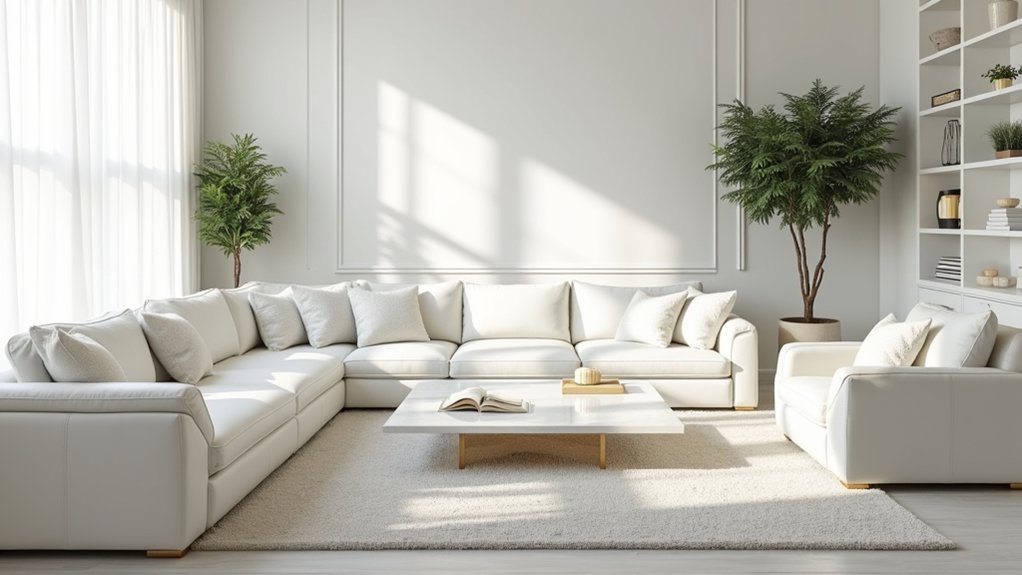
16 White Living Room Furniture Ideas That Are Timeless and Trendy
White living room furniture remains timeless and trendy when enhanced by layered textures—like boucle, velvet, and linen—paired with warm, earthy accents such as natural wood or brown highlights for visual depth. Expert use of soft ambient lighting, curated artwork, and sculptural accessories raises both comfort and sophistication. Introducing touches of greenery provides liveliness, while statement pieces in bold hues or tonal mixes set focal points. Explore textures, tones, and spatial layouts to master white living room design further.
Key Takeaways
- Layer plush area rugs, boucle cushions, and velvet throws to add warmth and tactile interest to all-white living room furniture.
- Incorporate sculptural white sofas or accent chairs for a modern focal point that remains timeless and adaptable.
- Use natural wood elements and earthy-toned accessories to soften white furniture and create inviting contrast.
- Add curated artwork, mirrors, and vases in white or neutral frames to personalize and elevate the space.
- Opt for layered lighting with white or brass fixtures to enhance coziness and highlight the clean lines of white furniture.
Layer Textures for Added Warmth
A strategic layering of textures is essential for infusing warmth and visual complexity into a white living room. By layering different textures—such as plush area rugs, boucle upholstery, and velvet accents—designers achieve tactile richness and subtle visual intrigue. Soft furnishings, including cushions and knitted throws, not only add warmth and depth but also enhance comfort, preventing the space from appearing sterile. Contrasting textiles, like smooth leather juxtaposed with nubby knits, generate a dynamic interplay of surfaces. Layering rugs for warmth and aesthetic appeal is key, as combining complementary colors and different textures can define spaces and enhance sophistication. Intentionally draped throws in bold primaries or graphic prints introduce focal points, breaking the monochromatic continuity. Additionally, integrating furniture with varied profiles, such as pairing curved sofas with angular coffee tables, furthers the layered effect. This multidimensional approach guarantees the white living room remains both inviting and visually stimulating.
Introduce Grounding, Earthy Tones
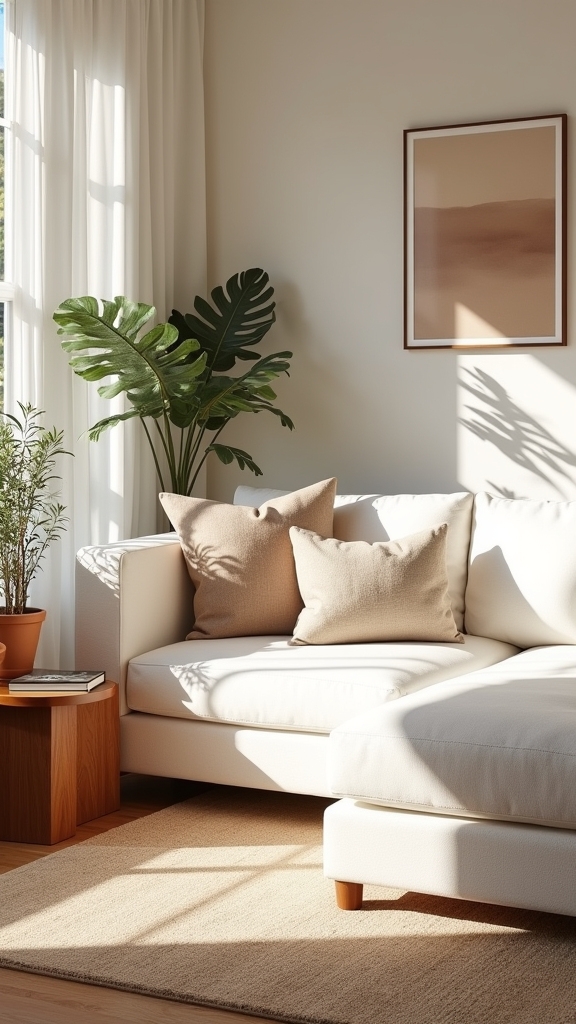
Integrating warm brown accents, sage green highlights, and natural wood elements establishes a harmonious contrast within a primarily white living room. These grounding hues introduce visual depth and tactile richness while maintaining a tranquil, cohesive palette. Employing this curated mix enhances spatial warmth and reinforces biophilic design principles, fostering both comfort and serenity. Additionally, incorporating layering brown tones and textures can further enhance the depth and richness of the space, creating a multi-dimensional and inviting environment.
Embrace Warm Brown Accents
While white living rooms evoke a sense of crisp serenity, introducing warm brown accents—such as deep wood tones and creamy taupes—anchors the space with visual depth and tactile richness.
This interplay between white living room ideas and earthy elements is fundamental to achieving balanced interiors.
Wooden furniture, particularly in robust finishes like walnut or oak, provides a grounded counterpoint to white walls, fostering a harmonious interplay of light and dark.
Warm brown accents in the form of coffee tables, shelving, or even subtle décor accessories create visual rhythm and prevent the space from feeling sterile.
Integrating these tones not only adds dimensionality but also infuses the room with a welcoming, lived-in quality—key attributes that enhance both functionality and aesthetic value in contemporary living room design.
Add Sage Green Highlights
Building upon the warmth introduced by brown accents, sage green offers a sophisticated method to infuse white living rooms with grounding, earthy undertones.
Integrating sage green highlights—whether through accent chairs, throw pillows, or curated décor—creates a harmonious contrast against white living room furniture, enriching the palette with subtle chromatic depth. This hue balances the inherent coolness of white, promoting a calming ambiance and enhancing visual interest without overwhelming the minimalist aesthetic.
Expert application of sage green, such as functional furniture finishes or botanical-inspired textiles, establishes cohesion while preserving the room’s fresh, airy quality.
The addition of sage green elements not only enhances design narrative but also fosters a serene, inviting environment, making the space adaptable for both seasonal updates and enduring trends.
Incorporate Natural Wood Elements
Embracing natural wood elements in a white living room introduces grounding, earthy tones that counterbalance the starkness of a monochromatic palette.
Wooden accents—ranging from deep brown coffee tables to creamy taupe shelving—add warmth and sophistication, complementing the crispness of a white backdrop.
The interplay of various wood finishes with subtle green highlights, such as sage textiles, achieves a curated, nature-inspired ambiance that promotes relaxation and mindfulness.
Functional natural wood elements, like rustic tables or sleek bookcases, offer a harmonious blend of visual interest and practical utility.
Incorporating diverse textures—smooth woods juxtaposed with plush fabrics—prevents monotony, establishing depth and dimension in the space.
This expert integration of wood within a white scheme creates an inviting, timeless living environment rooted in design balance.
Embrace the Scandinavian Concept of Hygge
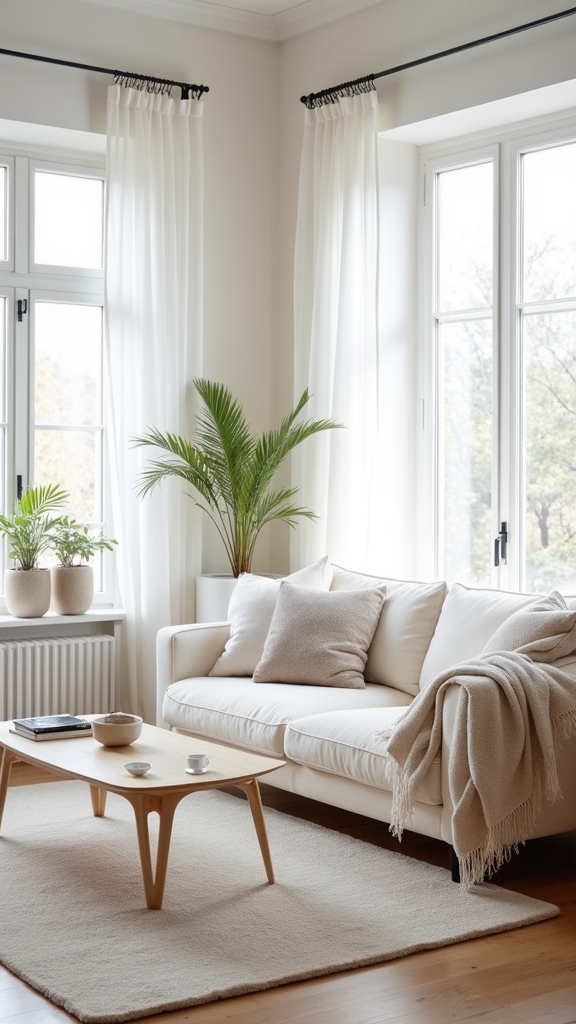
How does the Scandinavian concept of hygge redefine white living room design? Hygge introduces a sophisticated balance between minimalism and warmth, prioritizing atmosphere over ornamentation. In a cozy white living room, the interplay of natural materials such as light oak, wool, and cotton textiles fosters tactile comfort and visual serenity. The strategic use of warm, honey-toned accents within white palettes enhances depth and creates an inviting ambience. Layered lighting—combining ambient, task, and accent sources—is essential, casting a soft, enveloping glow that accentuates the sense of intimacy central to hygge. Multifunctional furniture selections maintain spatial clarity, reinforcing the uncluttered aesthetic while supporting relaxation and conviviality. Incorporating functional and multi-purpose furniture creates utility while maintaining a clean and uncluttered look. Ultimately, the hygge approach transforms a white living room into a haven of understated comfort and enduring tranquility.
Personalize With Artwork and Accessories

What transforms a pristine white living room from a blank canvas into a distinctive, expressive space is the deliberate integration of artwork and accessories. Curated artwork injects color and character, establishing a focal point that enhances the room’s ambiance. Gallery walls, featuring diverse art pieces and personal photographs, introduce visual rhythm while reflecting personal touches. Accessories—vases, sculptures, and decor—bring tactile variety and strategic color contrasts, enriching the spatial narrative. By updating these elements seasonally, the environment remains dynamic and relevant. The interplay of art and accessories is governed by balance, scale, and proportion, ensuring cohesion within the minimalist palette. With the growing trend of eco-friendly wall accents, incorporating sustainable planters or upcycled art can enhance the natural charm of your space.
Choose the Right Lighting
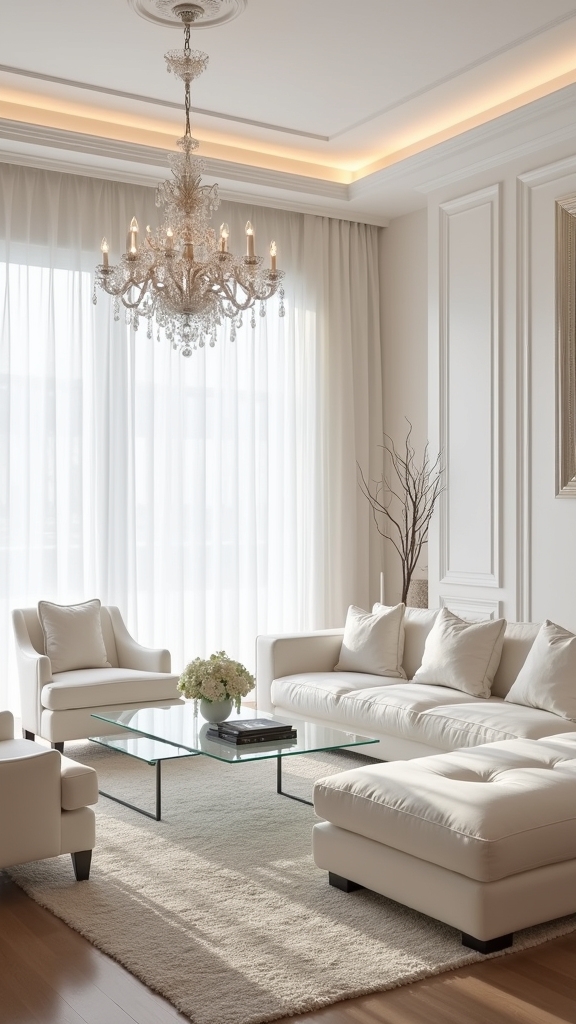
A carefully orchestrated lighting scheme is essential for elevating a white living room beyond mere minimalism, establishing both visual depth and atmosphere.
In a mainly white space, lighting does more than illuminate; it shapes the room’s mood and accentuates its design narrative. To confirm the space feels cozy rather than clinical, experts recommend a layered approach that balances function and aesthetics.
Consider the following strategies:
- Layered Lighting: Combine overhead, task, and accent lights to create dimensionality and warmth.
- Warm Light Tones: Opt for soft whites or subtle yellows to foster a welcoming, relaxed ambience.
- Dimmers: Integrate dimmer switches for tailored brightness, enhancing versatility for various activities.
- Unique Fixtures: Select statement pieces—such as sculptural floor lamps—to add unique style without overwhelming minimalist sensibilities.
Incorporating soft ambient lighting can further enhance the cozy feel of a white living room, offering a warm glow that softens shadows and promotes relaxation.
Create a Lived-In Feel With Coffee Table Styling
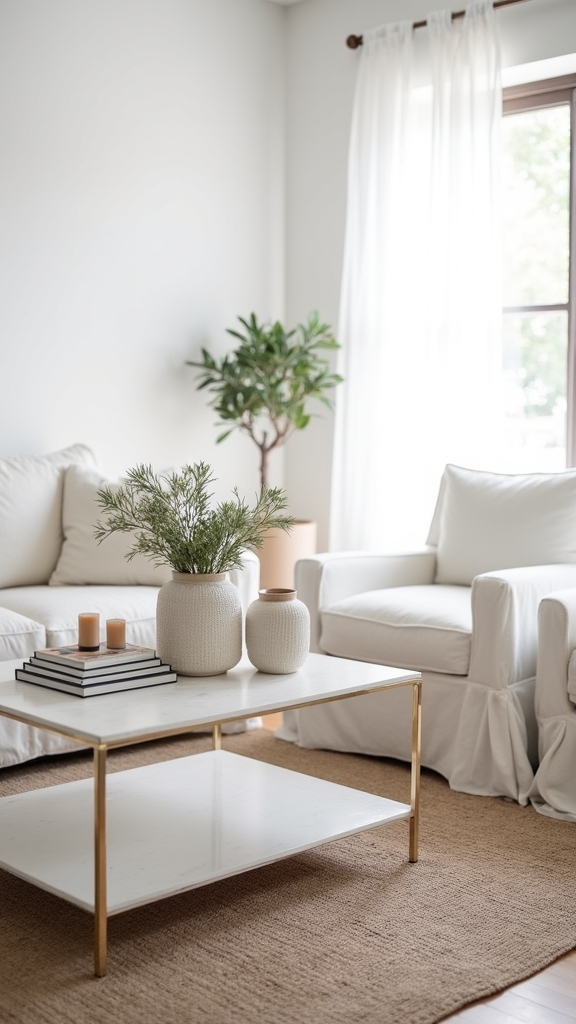
Coffee table styling introduces a curated focal point that enhances both function and aesthetic cohesion within a white living room. A thoughtfully selected centerpiece—paired with a restrained collection of complementary objects—anchors the arrangement while preventing visual clutter. The integration of personal mementos or seasonal accents invites narrative interest, transforming the table into a compelling visual story. Mixing textures and materials enhances the aesthetic appeal, ensuring the table is not only functional but visually engaging as well.
Curate Thoughtful Centerpieces
When thoughtfully styled, the coffee table becomes a dynamic focal point within a white living room, balancing aesthetic cohesion with individual expression.
To curate thoughtful centerpieces, designers recommend a restrained yet impactful approach, ensuring accent pieces enhance rather than overwhelm the space. A well-composed coffee table not only grounds the room but also reflects the homeowner’s personality through intentional selection and arrangement.
Consider these fundamentals:
- Limit object count: Select 3–5 meaningful accent pieces to maintain visual clarity and avoid clutter.
- Include a statement centerpiece: Anchor the table with a visually compelling element like a sculptural vase or distinctive artwork.
- Vary object heights: Utilize stacked books or trays to introduce dimension and guide the eye.
- Adhere to a motif: Curate objects by theme for cohesion and mood-setting.
Tell a Visual Story
How might a coffee table transcend mere functionality to become a narrative device within a white living room? Through curated living room décor, the coffee table acts as a visual focal point, showcasing layered different elements that speak to the homeowner’s personality.
Design principles emphasize restraint—selecting a few meaningful objects, such as a sculptural vase, a stack of artful books, or a cherished travel keepsake, prevents clutter while enhancing aesthetic cohesion. Themed vignettes—seasonal florals or curated collections—invite visual interest and a sense of story, making the space feel intentionally lived-in.
Regularly renewing these elements injects dynamism, aligning the décor with evolving moods and trends. Ultimately, a thoughtfully styled coffee table anchors the room, transforming everyday objects into compelling conversation starters.
Design a Multifunctional Space
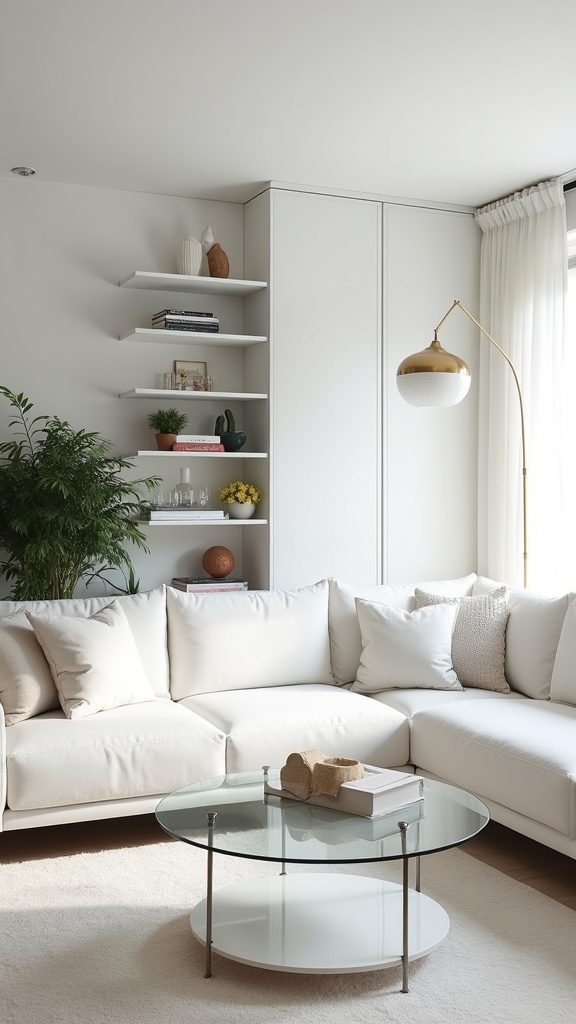
By delineating distinct zones for reading, working, and socializing, a white living room can achieve true multifunctionality without sacrificing aesthetic cohesion.
Expert design tips recommend utilizing the monochromatic palette to visually expand the functional space, while maintaining unity across different activities. Purposeful furniture placement, such as using white room dividers or shelving, subtly separates zones but preserves openness and light.
Versatile furniture—like ottomans with concealed storage and modular sofas—enhances utility and prevents clutter. To maximize both flow and harmony, designers suggest:
- Positioning furniture to encourage seamless movement between zones.
- Selecting multipurpose pieces to increase spatial flexibility.
- Employing white or soft-toned dividers for visual continuity.
- Unifying the design with complementary textures and finishes.
Incorporating strategic and layered lighting can further enhance the ambiance and functionality of different zones, allowing for a balance of brightness and mood.
This approach creates a refined, highly functional space tailored to contemporary living.
Select Cozy Textiles
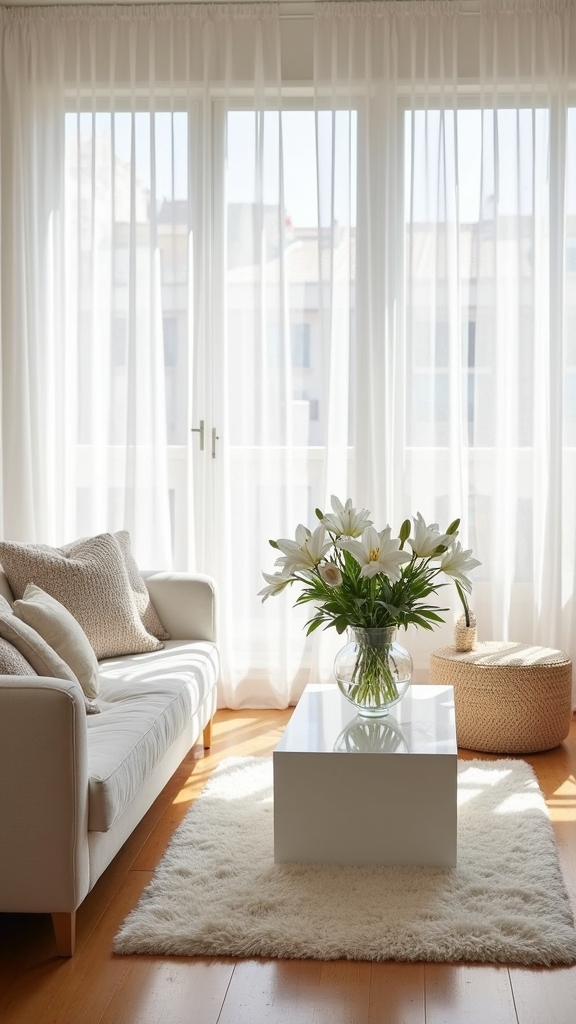
A thoughtful selection of cozy textiles is essential for infusing warmth and tactile richness into a white living room. Expert designers advocate for the strategic layering of textiles—think plush wool rugs, velvet cushions, and knitted throws—to create visual depth and enhance comfort. Opting for warm colors, such as creamy beiges or muted pastels, counterbalances the coolness of a white palette, lending the space a welcoming ambiance. Seasonal textile rotation, like exchanging summer linens for heavier wool or faux fur in winter, keeps the decor fresh and adaptable. Incorporating chunky knit throws and faux-fur rugs can significantly elevate the coziness of the space. The following table outlines key textile choices and their design impacts:
| Textile Type | Design Impact |
|---|---|
| Wool Rug | Adds warmth, grounds space |
| Velvet Cushion | Introduces softness, sheen |
| Knitted Throw | Enhances texture, coziness |
| Woven Blanket | Layers depth, visual interest |
Incorporate Greenery
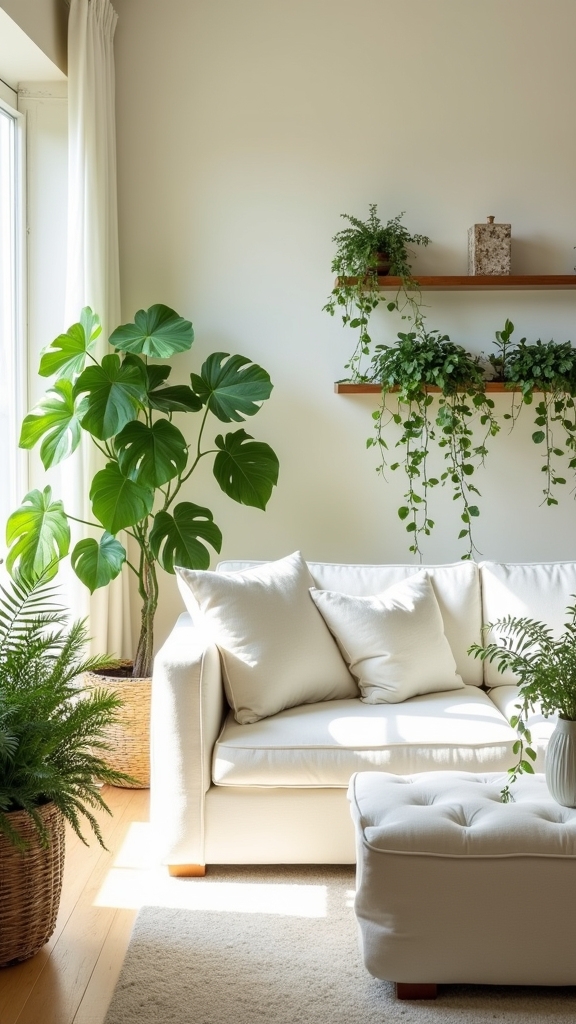
While a primarily white living room establishes a serene and airy foundation, the deliberate integration of greenery introduces essential vibrancy and organic texture.
A white living room gains vitality and warmth when thoughtfully accented with lush greenery and natural textures.
To thoughtfully incorporate greenery and add layers to a white living room, designers strategically utilize botanical elements that serve both functional and aesthetic purposes.
Consider the following techniques:
- Select resilient indoor plants—such as snake plants or pothos—to infuse dynamic color, texture, and purify the air.
- Group plants in varying heights and scales to create visual rhythm and break the uniformity of a monochromatic backdrop.
- Curate decorative pots that harmonize with the existing palette, ensuring the greenery seamlessly integrates with the overall decor.
- Prioritize placement in high-impact zones—corners, shelves, or beside sofas—to enhance comfort and evoke the Scandinavian principle of hygge.
- Introduce plants with unique characteristics like the Begonia Maculata or Alocasia Zebrina to add both visual interest and a touch of elegance to your decor.
Choose Rustic Storage Options
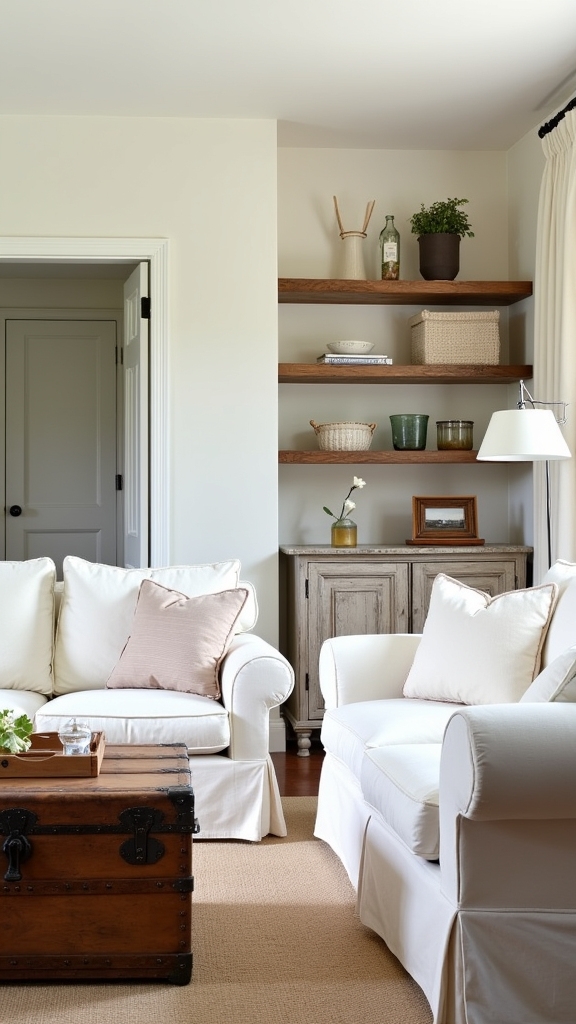
Infusing a white living room with rustic storage solutions introduces tactile depth and visual intrigue, grounding the space with authentic character. Expertly selected rustic storage options, such as wooden bookcases and vintage-inspired cabinets, offer both function and form, providing organized display zones for curated books and decorative artifacts. The inclusion of natural textures—distressed wood chests, repurposed crates, and reclaimed open shelving—contributes to a nuanced material palette, subtly breaking the monotony of a white backdrop. Multi-functional pieces, such as storage ottomans and coffee tables with concealed compartments, maintain a streamlined aesthetic, optimizing space without visual clutter. These elements harmonize with white décor, layering earthy undertones and organic finishes for a balanced, inviting environment that exemplifies the synergy of contemporary minimalism and rustic charm. Additionally, incorporating natural materials like wood and stone can create a rustic, warm ambiance that enhances the farmhouse decor theme.
Create a Cosy White Living Room With Wall Panelling
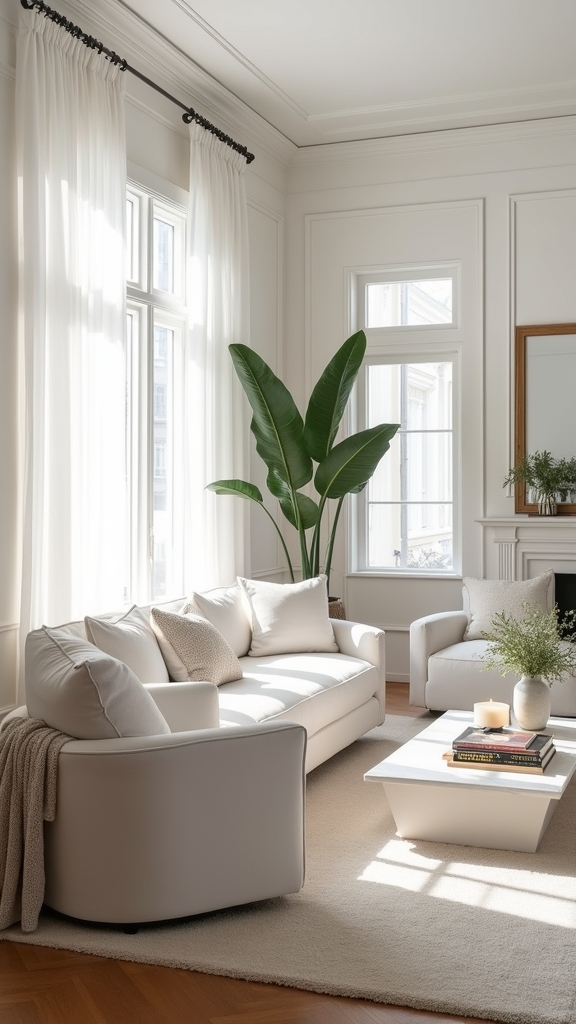
Incorporating wall panelling into a white living room amplifies architectural interest, introducing refined depth and tactile variation to the space. Wall panelling offers a strategic approach to transforming a sterile environment into an inviting retreat, expertly balancing visual intrigue with a cohesive look.
Design professionals highlight several impactful applications:
Experts point to creative panelling techniques as key to transforming white living rooms with added depth, elegance, and visual interest.
- Classic shiplap delivers rustic charm while enhancing depth and dimension along expansive white walls.
- Geometric panelling patterns raise contemporary aesthetics, producing tailored rhythm and subtle shadow play.
- Monochromatic white finishes on panelling unify the scheme, ensuring seamless integration with existing décor for a cohesive look.
- Custom paint or decorative treatments on panels provide opportunities for creative expression while maintaining understated elegance.
This versatile design element is accessible, allowing homeowners to achieve warmth and sophistication with minimal intervention.
Pair White Walls With Furniture

Building upon the architectural depth introduced by wall panelling, pairing white walls with thoughtfully selected white furniture strengthens the sense of spatial cohesion and visual clarity.
A modern white living room benefits from a curated interplay of layered whites, where a crisp white sofa, sheer curtains, and a streamlined coffee table amplify the room’s inherent luminosity.
The use of subtle contrast is achieved through textural differentiation—such as matte versus gloss finishes or woven fabrics juxtaposed with smooth surfaces.
Integrating rustic wood or metallic accents introduces delicate visual tension, preventing monotony within the monochromatic schema.
Additionally, the inclusion of diverse furniture styles—ranging from modern to vintage—adds dimension and sophistication.
Striking abstract artwork in warm tones against white walls punctuates the space, infusing depth while preserving minimalist balance.
Elevate Your Space With Stylish White Accessories
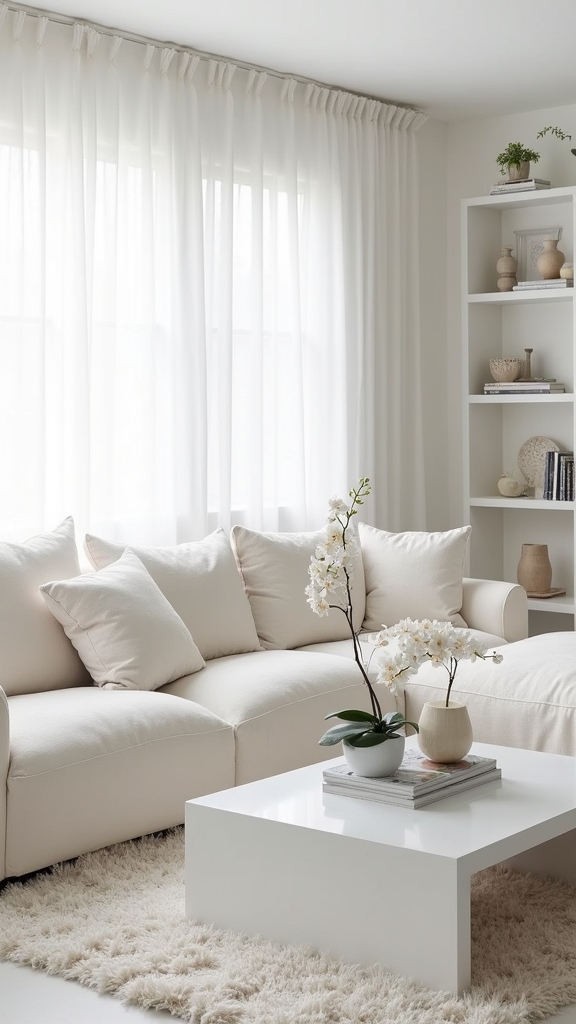
While a white living room establishes an airy foundation, the strategic addition of white accessories refines the overall composition and enhances the design narrative.
White accessories not only enhance the brightness of the space but also provide a sophisticated, cohesive visual rhythm. Expert designers deploy these elements to add depth and visual intrigue while maintaining a minimalist palette.
Consider the following impactful ways to leverage white accessories:
- Sculptural vases and ceramic décor—serve as focal points and introduce organic silhouettes.
- White-framed mirrors—amplify natural light and expand the spatial perception.
- Sleek white floor lamps—offer functional illumination and sculptural presence.
- Gallery-style white picture frames—personalize the environment without disrupting the unified aesthetic.
Carefully curated, these accents foster elegance and enhance the living room’s ambiance.
Experiment With Different Textures and Materials
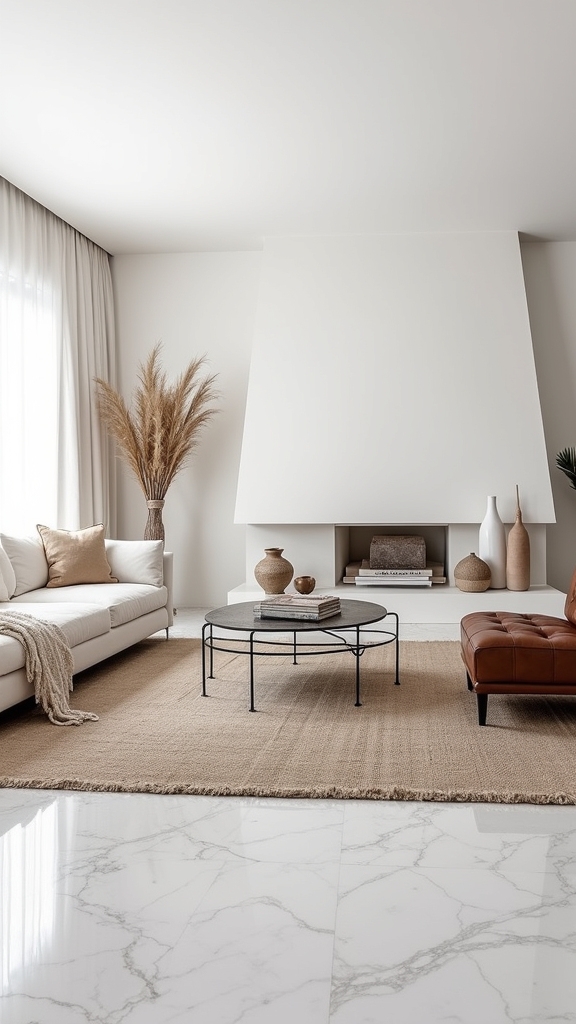
Though a monochromatic palette forms the backbone of a white living room, deliberate interplay of textures and materials is essential to avoid visual flatness.
By integrating plush rugs, boucle cushions, and tasselled pouffes, designers introduce tactile variety, cultivating a cozy ambiance that disrupts uniformity.
Natural materials—such as wood, leather, and linen—impart warmth and depth, enhancing the space’s inviting character without diminishing its minimalist integrity.
Layering textiles in tonal variations of white and cream enriches visual interest while maintaining cohesion.
A juxtaposition of matte ceramics with glossy metallics injects subtle contrast, ensuring the room remains dynamic rather than sterile.
Seasonally rotating heavier or lighter fabrics further refreshes the environment, preserving both comfort and style throughout the year.
Make a Statement With a Bold Coloured Sofa
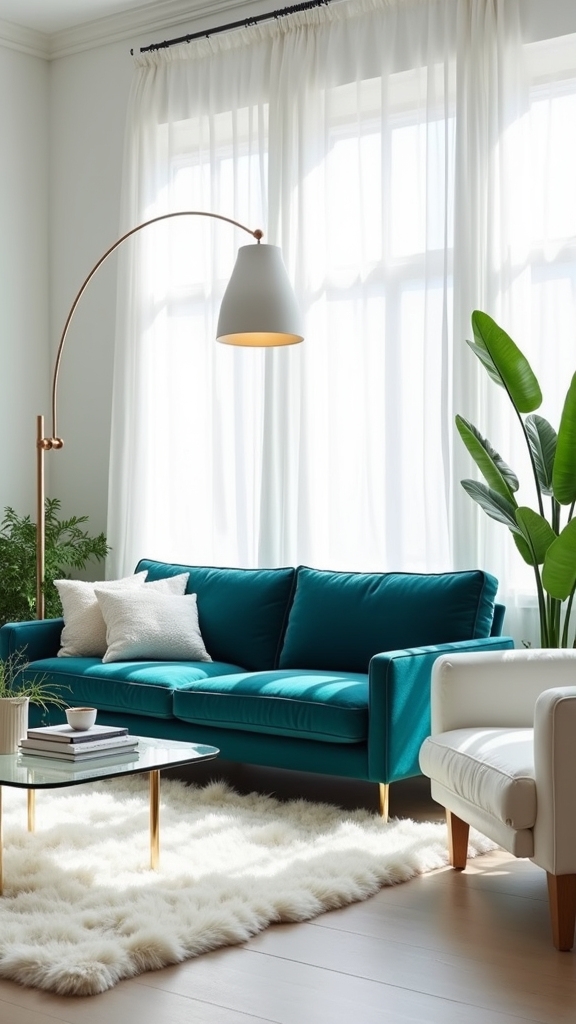
A vibrant sofa in hues such as petrol blue or forest green introduces an immediate focal point within an all-white living room, anchoring the composition with saturated color.
This strategic use of bold upholstery enhances visual hierarchy while allowing for expressive personal style.
The interplay of intense color against a neutral backdrop establishes both balance and dynamic tension in the overall design scheme.
Choosing Vibrant Sofa Colors
When integrated thoughtfully, a bold coloured sofa—such as petrol blue or deep forest green—acts as a commanding focal point within a white living room, establishing a dynamic interplay between neutral backdrops and saturated hues.
These vibrant pops infuse the space with visual interest and define the overall aesthetic. Strategic color selection is rooted in design principles that prioritize cohesion and balance.
To achieve ideal results:
- Select a bold coloured sofa that harmonizes with existing accessories and the overarching palette.
- Use accent pillows or throws in analogous hues to reinforce the color story and maintain unity.
- Prioritize high-quality upholstery for enduring appeal and adaptability to evolving trends.
- Confirm the sofa’s placement maximizes its visual impact without overwhelming the room’s serene character.
This careful curation guarantees timeless vibrancy.
Creating a Focal Point
How can a well-chosen sofa instantly transform a white living room’s visual hierarchy? By introducing a bold coloured sofa, designers create a commanding focal point that immediately attracts attention and establishes visual interest within the neutral space.
Deep hues such as forest green or petrol blue infuse personality and warmth, counterbalancing the coolness of white surfaces. The sofa’s form and scale must harmonize with existing furnishings, ensuring the focal point does not disrupt spatial balance.
Expert use of subtle or neutral accessories around the bold coloured sofa amplifies its impact without causing visual clutter. To reinforce cohesion, select accent pillows or art pieces in complementary tones, echoing the sofa’s palette.
This layered approach highlights the focal point while maintaining a sophisticated, unified aesthetic throughout the living room.
Maximise Natural Daylight
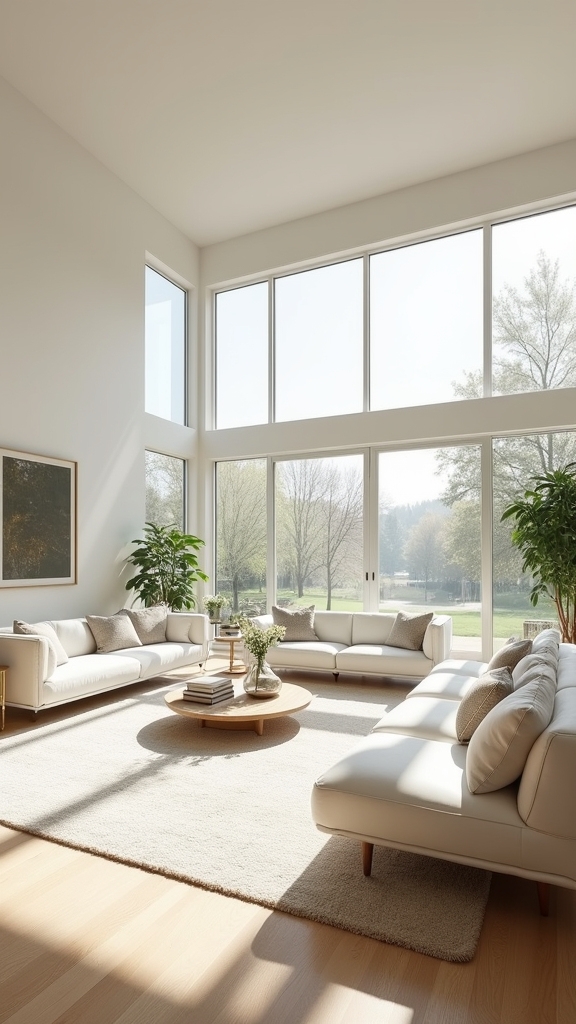
Maximising natural daylight is essential in white living rooms to reinforce their inherent brightness and sense of spaciousness.
Employing expert design principles, one can considerably enhance the luminous quality of the space while preserving its timeless appeal. To achieve ideal results and enhance visual emphasis:
- Hang sheer curtains to allow daylight to permeate while retaining privacy, ensuring a diffuse, airy glow.
- Position mirrors strategically to reflect light and visually expand the room, amplifying brightness and spatial perception.
- Select light-colored flooring—such as white-washed wood or pale oak—which helps bounce sunlight throughout the area for a consistently radiant atmosphere.
- Arrange furniture away from windows and introduce glass elements, like a transparent coffee table, to promote unobstructed light flow and further reflect light within the environment.
Frequently Asked Questions
What Furniture Looks Good in a White Room?
Selecting furniture for a white room, experts recommend minimalist designs to enhance spatial clarity, accent pieces in bold hues for focal interest, and texture contrast through materials like wood, metal, and textiles, ensuring visual depth and balanced composition.
What Color Furniture Is Timeless?
In interior design, timeless furniture colors emerge from classic color palettes—think neutrals like beige, taupe, and gray—paired with enduring material choices such as wood. Neutral accent options further enhance versatility, ensuring lasting relevance across evolving design principles and aesthetics.
What Is the 2/3 Rule for Furniture?
The 2/3 rule for furniture placement is a design principle advocating that furniture should occupy approximately two-thirds of a room’s height, promoting aesthetic balance and design harmony by ensuring proportional relationships and visually pleasing spatial arrangements.
What Color Goes With a White Living Room?
Selecting color accents for a white living room involves considering room dimensions and mood enhancement. Earthy tones, bold hues, metallics, or pastels can define zones, evoke ambiance, and visually expand or anchor the space, adhering to professional design principles.
Conclusion
A white living room becomes both timeless and trend-forward when anchored by expert layering of textures, strategic lighting, and curated accents. By integrating earthy tones, Scandinavian hygge, and personalized elements, each space achieves balance and depth. Thoughtful material selection—velvets, linens, ceramics—elevates visual interest, while bold color statements and maximized daylight act as focal points. Ultimately, these design principles guarantee a harmonious, inviting aesthetic that remains versatile and enduring in any modern home.
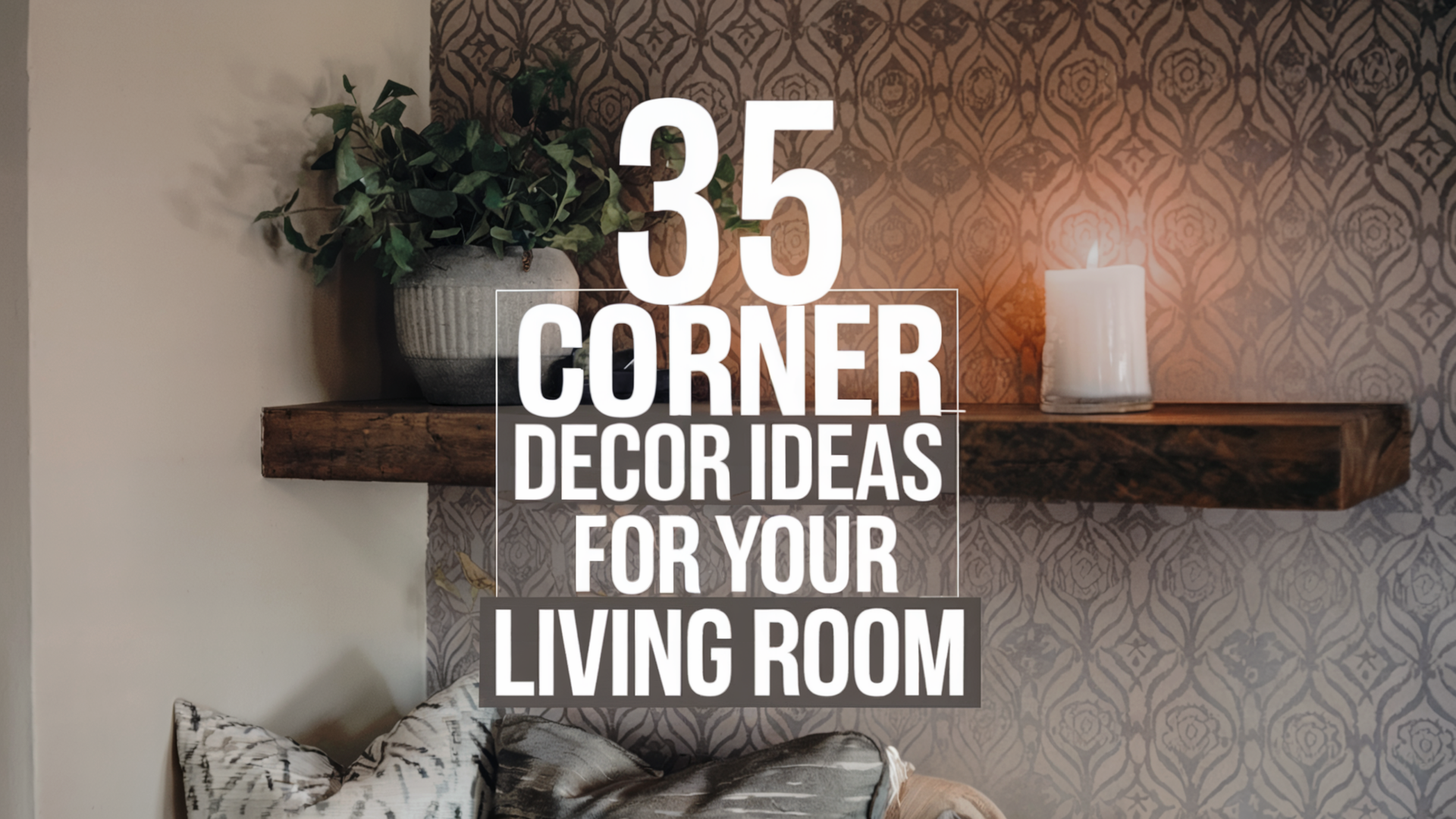
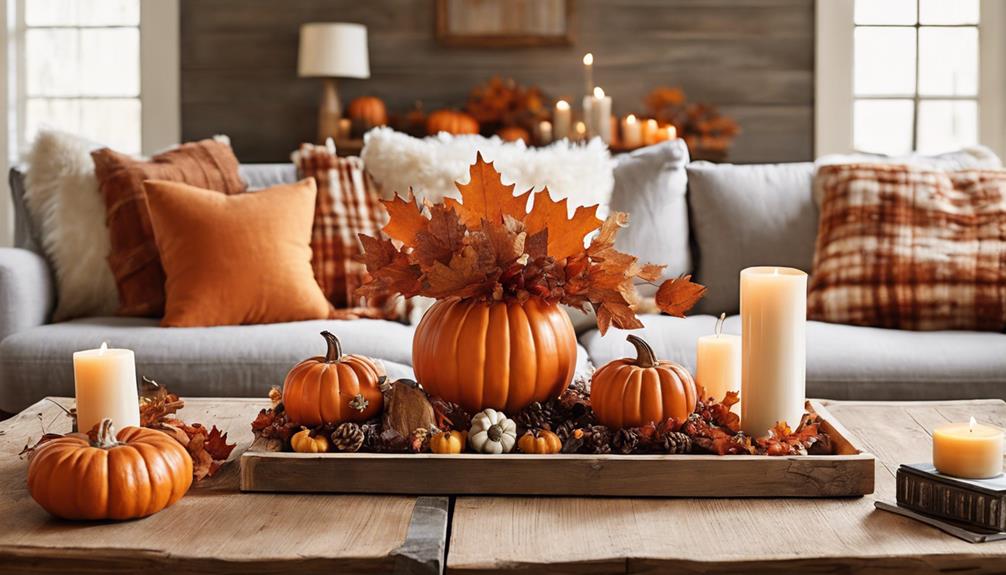
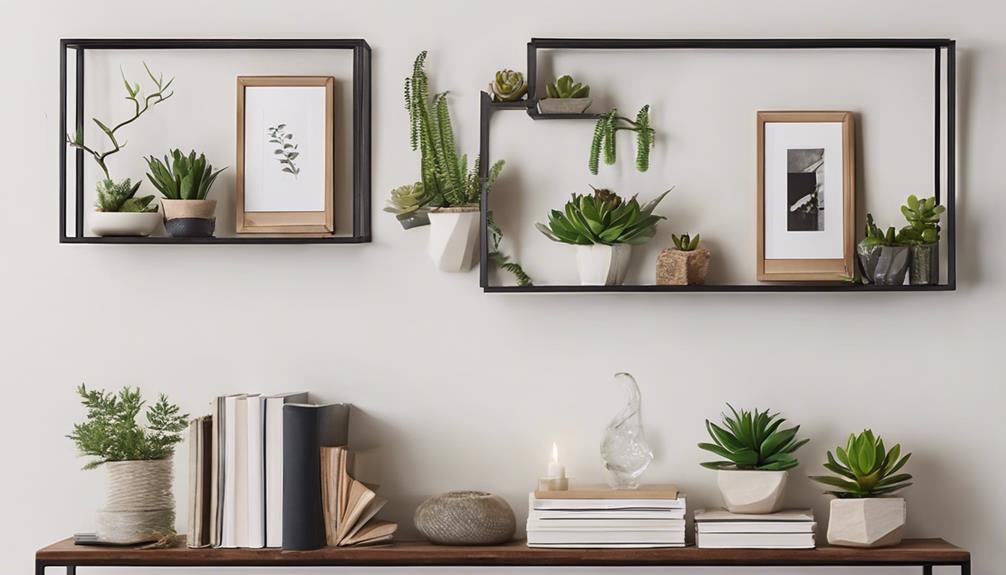
Leave a Reply